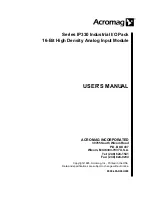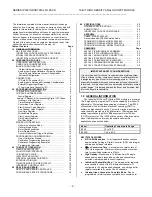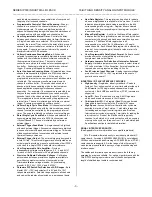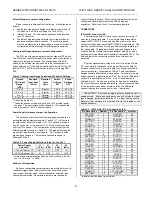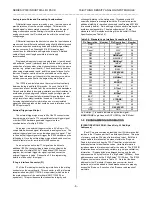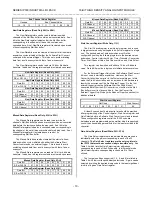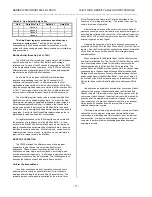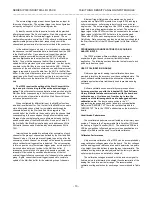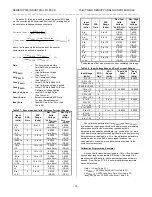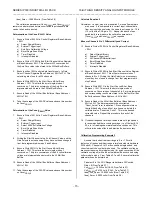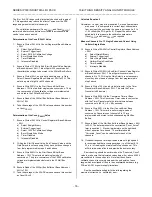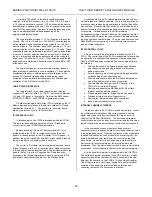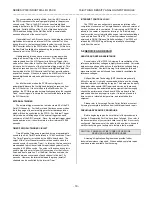
SERIES IP330 INDUSTRIAL I/O PACK 16-BIT HIGH DENSITY ANALOG INPUT MODULE
___________________________________________________________________________________________
- 4 -
Cables
Model 5025-551-X (Shielded Cable): A Flat 50-pin cable with
female connectors at both ends for connecting
AVME9630/9660, or other compatible carrier boards, to Model
5025-552 termination panels. The “-X” suffix of the model
number is used to indicate the length in feet. The shielded
cable is highly recommended for optimum performance with
the IP330 analog input module.
A shielded cable for the APC8600 ISA bus carrier is not
available directly from Acromag but is strongly recommended.
The cable is used to mate the high-density (25mil pitch) 50-pin
I/O connectors of the APC8600 carrier board to the high-
density connectors on the APC8600 Termination Panel. The
following vendors’ shielded ribbon cable and connector part
number information is provided to facilitate construction of
your own shielded cables.
Connector:
The connector is a 50-pin, high-density (25mil
pitch), female receptacle header (T&B Ansley Part 311-
050302 or equivalent). The connector mates to the male
connector (T&B Ansley Part 311-050072E or equivalent) on
the APC8600 carrier board at one end of the cable and the
APC8600 termination panel at the other end of the cable.
Cable:
50-wire flat ribbon cable, 30 gage, Shielded
(T&B/Ansley Part 188-050 or equivalent).
Termination Panels:
Model 5025-552: A DIN-rail mountable panel that provides 50
screw terminals for universal field I/O termination. Connects
to Acromag AVME9630/9660, or other compatible carrier
boards, via flat 50-pin ribbon cable (Model 5025-551-X).
Model 5029-910 APC8600 High-Density-to-Screw-Terminal
Termination Panel: This panel converts the high-density
ribbon-cable connectors coming from the APC8600 carrier
board to screw terminals, for direct-wired interfaces.
Transition Module:
Model TRANS-GP: This module repeats field I/O connections
of IP modules A through D for rear exit from a VMEbus card
cage. It is available for use in card cages which provide rear
exit for I/O connections via transition modules (transition
modules can only be used in card cages specifically designed
for them). It is a double-height (6U), single-slot module with
front panel hardware adhering to the VMEbus mechanical
dimensions, except for shorter printed circuit board depth. It
connects to Acromag Termination Panel 5025-552 from the
rear of the card cage, and to AVME9630/9660 boards within
the card cage, via flat 50-pin ribbon cable (cable Model 5025-
551-X).
INDUSTRIAL I/O PACK SOFTWARE LIBRARY
Acromag provides an Industrial I/O Pack Software Library
diskette (Model IPSW-LIB-M03, MSDOS format) to simplify
communication with the board. Example software functions are
provided for both VMEbus and ISA bus (PC/AT) applications. All
functions are written in the “C” programming language and can be
linked to your application. For more details, refer to the
“README.TXT” file in the root directory on the diskette and the
“INFO330.TXT” file in the appropriate “IP330” subdirectory off of
“\VMEIP” or “\PCIP”, according to your carrier.
2.0 PREPARATION FOR USE
UNPACKING AND INSPECTION
Upon receipt of this product, Inspect the shipping carton for
evidence of mishandling during transit. If the shipping carton is
badly damaged or water stained, request that the carrier's agent
be present when the carton is opened. If the carrier's agent is
absent when the carton is opened and the contents of the carton
are damaged, keep the carton and packing material for the agent's
inspection.
For repairs to a product damaged in shipment, refer to the
Acromag Service Policy to obtain return instructions. It is
suggested that salvageable shipping cartons and packing material
be saved for future use in the event
the product must be shipped.
This board is physically protected with
packing material and electrically
protected with an anti-static bag
during shipment. However, it is
recommended that the board be
visually inspected for evidence of
mishandling prior to applying power.
The board utilizes static sensitive
components and should only be
handled at a static-safe workstation.
CARD CAGE CONSIDERATIONS
Refer to the specifications for loading and power requirements.
Be sure that the system power supplies are able to accommodate
the power requirements of the carrier board, plus the installed IP
modules, within the voltage tolerances specified.
IMPORTANT: Adequate air circulation must be provided to prevent
a temperature rise above the maximum operating temperature.
The dense packing of the IP modules to the carrier board
restricts air flow within the card cage and is cause for concern.
Adequate air circulation must be provided to prevent a
temperature rise above the maximum operating temperature and
to prolong the life of the electronics. If the installation is in an
industrial environment and the board is exposed to environmental
air, careful consideration should be given to air-filtering.
BOARD CONFIGURATION
The board may be configured differently, depending on the
application. All possible DIP switch and jumper settings will be
discussed in the following sections. The DIP switch and jumper
locations are shown in Drawing 4501-590.
Remove power from the board when configuring hardware
jumpers, installing IP modules, cables, termination panels, and
field wiring. Refer to Mechanical Assembly Drawing 4501-434 and
the following paragraphs for configuration and assembly
instructions.

